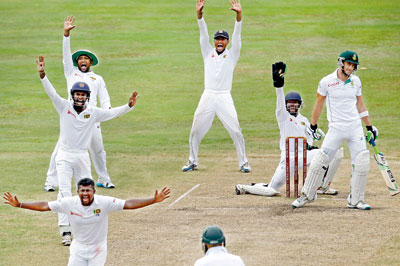Think of neutral ‘batting tracks’ too
View(s): Talking of Boxing Day, I discovered that though the incomparable Cricket legend Kumar Sangakkara made his debut in 2000, he became a part of the cricket community’s folklore on Boxing Day of the same year, while facing up to the wrath of South African pace in Durban during the 1st Test.
Talking of Boxing Day, I discovered that though the incomparable Cricket legend Kumar Sangakkara made his debut in 2000, he became a part of the cricket community’s folklore on Boxing Day of the same year, while facing up to the wrath of South African pace in Durban during the 1st Test.Both openers — skipper Sanath Jayasuriya and Marvan Atapattu – the two senior men in the batting order had big zeros and it was up to the two greenhorns, Kumar Sangakkara and Mahela Jayawardena, to stage the fightback.
They did it in style. From 2 for 2, the score had moved to 170, before the next wicket fell. Sangakkara made a personal best at that time of 74, while Jayawardena, the senior of the two, missed a well deserved century by two runs. Then tragedy struck again. From a respectable 170 for 2, the Lankans were all out 216. That was in reply to the Proteas 1st innings score of 420 all out.
So much so, writer Peter Robinson reporting on the game, did not write a single sentence about the 168 run stand between the two youngsters. I am sure, if the same stand came a decade later, the writer would have gone into raptures about the finesse and reassurance of the association. At that time, Sangakkara was an unknown quantity.
When Sangakkara’s mercurial 15-year reign came to close in 2015, he had played 134 Test matches and scored 12,400 runs at an average of 57.40 with the best being 319 against Bangladesh. He scored 38 hundreds and 52 half centuries, while hitting 1,491 boundaries and 51 sixes. His ODI exploits and T-20 records are also second to none.
His first hundred was against India in Galle, but his first overseas hundred was a double — 230 — against Pakistan in Lahore. Then his next two centuries were also doubles — 270 against Zimbabwe and 232 against South Africa.
In short, till he decided it was sufficient, Sangakkara kept on piling, and even after his international retirement, he is still scoring. Yes, he is one cricketer who scored a hundred against all Test-playing nations – a man for all terrain.
He did not care who the opposition was or, what ploy the opponent or the home team adopted. He believed in himself and his ability to dominate the foe, and did just that.
Yes, in contemporary cricket, there are a few exponents who have made their mark similar to Sangakkara. Vivian Richards and Brian Lara of the West Indies, Sachin Tendulkar, VVS Luxman, Rahul Dravid of India, Steve Waugh and Ricky Ponting of Australia, Jacques Kallis and AB de Villiers of South Africa, Joe Root of England are some of the other batsmen who could weather the storm on any terrain.

Remember, back in 2014, in Sri Lanka, it was a struggle for the Proteas to save the game and win the series. Yet, the bottom line was that South Africa were not totally comfortable against the Sri Lankan spin attack.
Yes, these batsmen were the gifted few who stood above the rest but, I do have a question: Is cricket, especially the longer version, on even keel?
Often I wonder, what really the home advantage is. Is it a ploy to win at any cost? You just pick your strong point and unashamedly thrust towards the advantage. For instance, in Australia or South Africa, you keep half-an-inch of grass on the wicket and the seamers just shove the rival team’s batsmen into subjugation. Then, in India and Sri Lanka, especially the curator, is requested to prepare a spinning wicket. They come up with a crumbling dried clay shining sheet to bowl on, and the spin bowlers trundle from the very first ball, and the opposition is tied up in curls trying to cope with the turners. Or else, England will invite an opponent who needs a little reprimand and call them up for a Test series as soon as the winter is over — while it is still cold — and alas! They have completed a resounding series win.
Is it cricket? At the same time, they are complaining that Test Cricket is wearing out its sheen.
At the same time, the custodian of cricket — the ICC — when they embark on a tournament like the World Cup or the Champion’s Trophy, they ensure that the wickets are 50-50 and, at the end of the road, it is the best prepared who wins the race, with no backdoor winners.
Wonder why all cricket could not be played on even keel, so that, there would not be any undeserving sides surfacing. Well, we do have neutral umpires. Then why cannot the authorities back it with wickets which are not biased.
However, Sidath Wettimuny feels differently. He thinks, having the home advantage is the magic of cricket. He says the home team should have the prerogative of playing to their strengths, and also prepare wickets to suit the home team. He said, “I remember once, after we had prepared some turners against Australia, they politely reminded us that, we would have to get prepared for some green topped rippers, once we are on Australian soil.”
Yet, at this end, we feel cricket is changing rapidly. In the past 50 years, cricket has deviated from Tests to ODIs, T-20s to day-night Test cricket with the pink ball now. This means, cricket in general, has even gone beyond the norms of accepted cricket.
Yes, there was a time when Clive Lloyd’s invincible ensemble or, Ian Chappell’s champion combination was truly better than the rest. Can you say the same of any of the combinations today? As a habit, the Australians win at home but, when they move to Sri Lanka they look a sorry and pathetic sight.
At one point, the present English team looked as if they had discovered the perfect combination to rule the rest of the world but, Ashwin and Jadeja pooh-poohed the whole myth during their last Indian series.
At the same time, the Indians are cock-a-hoop while playing in their own conditions but, when they go to England, they are down on their knees.
The results are so predictable, one can write the epilogue six months ahead. The ICC is spending millions of good cricket dollars on neutral umpiring, when the results of a Test series is so predictable.
We feel it is high time that the Cricket Committee of the ICC take a closer look at the state of affairs in international cricket and take over the reins of the preparations of international playing strips too.


